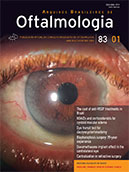Purposes: To identify problems caused by prosthesis-socket volume imbalances in anophthalmic sockets; and to evaluate rehabilitation with dermofat graft as a solution.
Methods: We retrospectively reviewed medical records of patients operated in our clinic (between May 2011 and June 2016) with dermofat grafts to treat anophthalmic socket-related problems. During the preoperative examinations, ophthalmologists recorded the presence of eyelid problems due to the socket volume deficit, upper and lower fornix deficiency, deepening in the upper eyelid sulcus, epiphora and secretion, lower eyelid laxity, ptosis, entropion, and ectropion. Following the surgical repair, new prosthesis suitable for the resulting socket area were implemented for all the patients. The mean follow-up period was 27.42±16 months (ranging from 10-62 months). On the last control examinations, ophthalmologists recorded solved and unsolved socket problems that were present preoperatively.
Results: We included 16 men and 5 women in this study. The mean age was 38.3 ± 18.4 years (range, 5-75 years). The mean duration of preoperative prosthesis use was 9.4 ± 6.8 years (range, 1-30 years). Preoperatively, 7 patients had only orbital volume deficits, and 14 had socket volume displacements in addition to the volume deficits. After the dermofat graft implantations, the remaining deficits were corrected during another surgical session: 6 patients underwent ptosis corrections, 5 lateral canthal suspensions, 5 lower fornix with mucosal graft formations, and 2 upper fornix formations with mucosal grafts. All patients were able to use prosthesis postoperatively.
Conclusion: The use of dermofat grafts to correct anophthalmic socket problems caused by orbital volume deficits or volume displacements is an effective, reliable, and reproducible surgical method.
Keywords: Anophthalmos; Orbital implants; Dermis; Prosthesis and implants; Ophthalmologic surgical procedures
